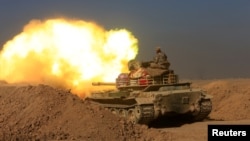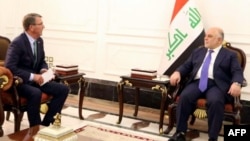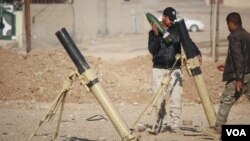Nearly two months into the assault on the Islamic State’s last major stronghold in Iraq, the unbridled optimism that accompanied the initial, rapid advance is gone.
Iraqi security forces, which had cut through IS defenses in the outer suburbs of the northern city of Mosul, have met with stiffer than expected resistance in the city’s east. Their losses have been significant and, to both Iraqi and U.S. officials, surprising.
“They front-loaded the fight,” a U.S. official told VOA, speaking on the condition of anonymity. “They threw a lot of their best fighters at east Mosul."
U.S. and Iraqi officials had expected the opposite, that IS would wait to make its strongest defense in the older, Western part of the city, making use of the narrower streets and counting, perhaps, on the support of Sunni-dominated neighborhoods.
Intelligence gathered prior to the assault on Mosul only served to reinforce that thinking, showing IS fighters concentrating their defenses to the West of the Tigris River, which cuts through the city. IS was ready, having made the most of the two years its fighters had occupied the city.
“They’re pretty well defended throughout,” said a second official, also requesting anonymity due to the subject’s sensitivity.
The official said making the fight more difficult is that IS commanders have “been adapting all along,” changing tactics to keep Iraqi forces off-balance as they push further into Mosul.
IS tactics
In defense, IS has used everything it can to slow advance, from mounting ambushes after appearing to be retreating, enticing Iraqi units forward, to launching an unexpected large number of suicide bombers in vehicles packed with huge amounts of explosives, to changing the design of improvised explosive devices (IEDs) and where they plant them.
“It is a cat-and-mouse game for bomb disposal teams, IS bomb-makers are quick to alert other IS members about changes that make it harder to defuse devices,” says Kurdish Gen. Mahmood Kakaye.
Iraqi security forces battling their way into Mosul, and Shi’ite militias in the countryside west of the city, are suffering heavy losses from the IEDs, much as the Kurds did in their battles close to Mosul, culminating in the seizing from IS of the town of Bashiqa last month.
The difficulty in taking territory from IS and then holding it was on clear display in Bashiqa.
Massively outnumbered by Kurdish forces, the up to 200 IS fighters, Kurdish military officials still can’t agree on how many jihadists defended the town in the final assault, proved to be a cunning enemy. After the center of the town had been seized by the Kurds there was almost another day of riotous gunfire and what the peshmerga termed chase-the-jihadist.
IS fighters kept popping up from a labyrinthine of tunnels dug under houses, launching attacks from 360 degrees. In one attack a key Kurdish bomb-disposal expert died when a suicide bomber suddenly appeared before him and embraced him in a death-hug as he detonated an explosive vest.
“ISIS has been very creative in the way that they are fighting,” Kurdistan Regional Security Council Chancellor Masrour Barzani said Thursday in Washington, using another acronym for the Islamic State group.
“When you go to the western bank of the Tigris River, we expect that the fighting is going to be even harder,” he said.
But Iraqi forces ran into a prime example of IS’ deadly creativity earlier this past Tuesday when they tried to take the city’s al-Salam hospital.
After initially meeting little resistance, the Iraqis were met with a fierce counterattack. More than a dozen suicide car bombs later, the soldiers were forced to beat a retreat with the help of a U.S. airstrike and Iraq’s elite Counter Terrorism Service.
Iraqi PM optimistic
Despite such setbacks, some optimism persists, with Iraqi Prime Minister Haider al-Abadi continuing to insist Mosul can be taken by year’s end.
Other Iraqi officials, such as the governor of Kirkuk province, think while that timeline may be a bit ambitious, it is not necessarily far off.
“The Mosul operation is actually going as well as it was expected. Nobody thought it is going to be something very quick,” Najmaldin Karim said during a visit to Washington late last month. “Maybe President [Barack] Obama will still be president [when it happens].”
Last week U.S. Defense Secretary Ash Carter agreed it was “certainly possible” Mosul could be taken before President-elect Donald Trump takes office on January 20.
“But this is a war, so I'm not going to predict that,” Carter added. “It's going to be a tough fight.”
Western diplomats based in Turkey are skeptical that the fight will be over before Trump is sworn-in.
“I think this could take another four months,” said a European attache who asked not to be named in this article. “I am suspicious of the numbers being bandied about in terms of IS casualties and people also forget about the casualties on our side, the Iraqis, as the Kurds, won’t give out the statistics about their own loses but I can tell you they are high."
He and other Western diplomats fear that by the time the Iraqi security forces have reached west Mosul, they will be exhausted, having fought for months, and will then have to call for help on the irregular Shi'ite militias around Tal Afar for assistance. The Iraqi government has promised not to use those militias, which have been accused of war crimes against Sunnis, in Mosul.
Help from Kurdish forces, at that point, is almost out of the question, Barzani indicated. “We are hoping the rest of the Iraqi security forces are able to finish the job.”
The fight ahead
Yet there is reason to think the fight will get somewhat easier. Military officials say the IS strategy of “front loading” the fight in the eastern part of Mosul could backfire.
Many of the terror group’s best fighters are dead. And U.S. officials insist the number of fighters has been whittled down considerably from an estimated 5,000 at the start of the Mosul operation in mid-October.
U.S. and coalition airstrikes have also destroyed four of the five Mosul bridges that span the Tigris River.
Other supply routes have also been cut off, either with the help of airstrikes or due to the advance of Iraqi militias, the so-called Popular Mobilization Forces or PMF, which have moved to cut-off Mosul from Tal Afar, a smaller IS stronghold to the west.
“Mosul is completely surrounded on all sides and Daesh have no ability to resupply or reinforce their fighters,” said Operation Inherent Resolve spokesman, Col. John Dorrian, using the Arabic acronym for the terror group.
Retired U.S. Army Lt. Gen. Michael Barbero, who once led the Pentagon efforts against IEDs in Iraq, remains cautious and says holding on to the city after taking it "is a different ballgame."
Many current U.S. officials believe IS intends to use any and all tactics at its disposal to turn Iraq's second largest city into "hell on earth.” They also point to what IS fighters were able to do in its former stronghold in Libya, as a model for what can be expected in Mosul.
Libyan forces, aided by hundreds of U.S. airstrikes, confined IS to just a few blocks in coastal city of Sirte. But it took hundreds of additional airstrikes and another month to finally rout IS from the city.
And there are worries about the preparations IS has made which cannot easily be seen. Some weapon experts fear IS will use mustard gas or other toxic material.
“They have totally dug into the sewer system,” said one of the U.S. officials, referring to the challenges that still await in the western part of Mosul. “A lot of this is going to be underground.”
And the Iraqis will face a lot more bombs.
According to a report to be published Wednesday by Conflict Armament Research, a Britain-based organization funded by the European Union that monitors the movement and use of conventional weapons, the jihadists’ IEDs “are anything but improvised.” The group will highlight in the report the high and rapid output of IEDs in IS’s Mosul workshops, all part of a centrally managed weapon production system that can churn out bombs to high military standards.












